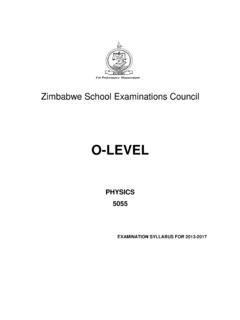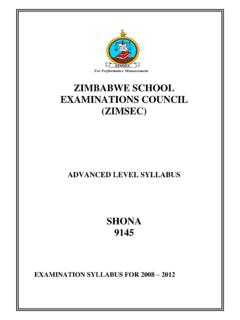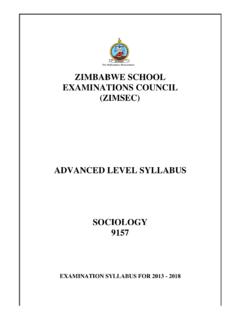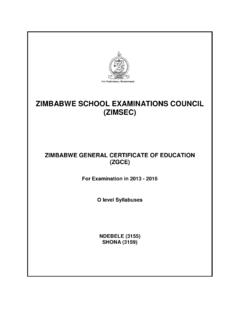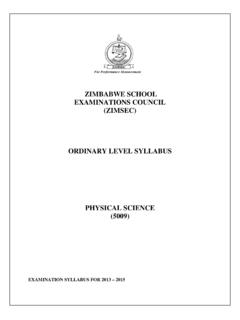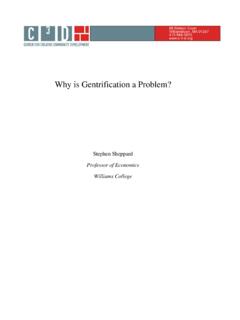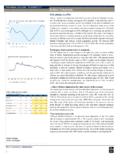Transcription of O LEVEL SYLLABUSES - ZIMSEC
1 ZIMBABWE SCHOOL EXAMINATIONS COUNCIL ( ZIMSEC ) ZIMBABWE GENERAL CERTIFICATE OF EDUCATION (ZGCE) For Examination In November 2012 - 2017 O LEVEL SYLLABUSES FASHION AND FABRICS (6051) FOOD AND NUTRITION (6064) home MANAGEMENT (6078) SS17 (ZIMB) 2012/2017 2 PREFACE In November 2012/2017, the following SYLLABUSES will be examined by the Zimbabwe School Examinations Council ( ZIMSEC ) at the ZGCE O- LEVEL . 1122 English Language* 2013 Literature In English* 2042 Religious Studies A* 2043 Religious Studies B* 2157 History (World Affairs Since 1919)* 2168 History (Southern And Central Africa)* 2166 History* 2248 Geography* 2252 Sociology* 2283 Economics* 2292 Law* 3001+ Latin 3011 French 3025+ German 3035 Spanish 3151 Afrikaans 3155 Ndebele 3159 Shona 4008/4028 Mathematics* 4033 Additional Mathematics* 4034 Additional Mathematics* 4041 Statistics* 5006 Integrated Science* 5007 Biology* 5008 Biology* 5009 Physical Science* 5034 Agriculture* 5040 Agricultural Science* 5055 Physics* 3 5071 Chemistry* 5097 Human and Social Biology* 5127 Science (Physics/Biology)* 5128 Science (Chemistry/Biology)
2 * 6015 Art 6020 Music 6035 Woodwork 6045 Metalwork 6051 Fashion And Fabrics 6064 Food And Nutrition 6078 home Management 7014 Computer Studies 7035 Building Studies 7049 Technical Graphics 7065+ Electronics 7103 Commerce* 7108 Commercial Studies 7112 Principles Of Accounts* 7116 Business Studies* *Indicates SYLLABUSES available in June +Indicates SYLLABUSES available from UCLES 4 Subject 6051: Fashion and Fabrics 5 SUBJECT 6051 FASHION AND FABRICS PREAMBLE Fashion and Fabrics is the area of home Economics which deals with the study of fashion, clothing, fibres and crafts. The Course: uses a scientific and problem solving approach to identify fibres and fabrics as a basis for garment construction in a socialist and multicultural Zimbabwe; creates an awareness and ability to solve perennial practical problems related to clothing needs for different age groups, cultures and occasions; imparts an understanding of the various clothing needs of the Zimbabwean population; is a foundation for further studies related to textiles and textile technology; is a gateway to many professions in the textile industry; develops skills for self-reliance and consumer competence; stresses the use of locally available materials in the construction of garments and other household goods.
3 AIMS The aims of the syllabus are to develop: the ability to identify, analyse and evaluate the principles underlying the choice and use of different fabrics, styles and colours in the construction of clothing and textile goods; 6 knowledge, interest and skills in designing, construction and caring for clothes, accessories and household goods; an awareness and appreciation of good workmanship related to fashion and technology; consumer competence; a base for further studies, training, future employment, creativity, initiative and enjoyable and profitable use of leisure time; co-operation, entrepreneurship and managerial skills; critical and analytical skills in solving problems. ASSESSMENT OBJECTIVES Pupils should be able to: identify, analyse and evaluate different natural and synthetic fibres, yarns and fabrics; demonstrate the correct handling, use and care of different fabrics; design and draft patterns; demonstrate competence in the selection of patterns, fabrics, notions and processes; apply the knowledge and skills acquired in the course, in the construction of well-finished garments, accessories and craft; explain how to choose, care for and maintain various pieces of equipment; 7 explain and demonstrate the uses of various pieces of equipment including modern technology; apply managerial and organisational skills to efficient use of materials, time, money, labour and equipment; explain the efficient use of locally available resources in an income generating scheme; exercise consumer rights and responsibilities.
4 Observe safety precautions in fashion and fabrics ASSESSMENT OBJECTIVES (as in paragraph 3 above) COMPONENTS Paper 1 Paper 2 Paper 3 1 + + 2 + + 3 + + 4 + + 5 + + 6 + 7 + + + 8 + 9 + 10 + 11 + + + METHODOLOGY Six to eight periods per week should be allocated, four of which should be consecutive and used for practical lessons. To achieve the stated aims and objectives the following are necessary: teaching through theory and coursework; 8 teacher demonstration, followed by pupil practice in the use of practical skills; experimentation with fibres, fabrics and equipment; group and individual instruction and supervision; the use of learning and teaching aids, charts, samples, specimens, books and magazines; class discussions; individual written assignments; encouragement of community involvement, talks, demonstrations by talented local people; community projects toy making; use and improvisation of facilities and resources in the environment; educational tours; liaison with other relevant subjects, technical graphics and science.
5 9 CONTENT Topics Fibres and Fabrics (i) Fibres origin, appearance, identification, properties of the following: Natural cotton, linen, wool, silk; Regenerated viscose, acetate, triacetate; Synthetic polyamide (nylon), polyester, acrylic (ii) Fibres to yarns Processes involved including: blending, carding, combing and spinning. (i) Fabric Construction Techniques used to include weaving, knitting and bonding (felting). (ii) Colour in yarns Processes involved including: and fabrics dyeing and printing. (iii) Fabric finishes Details of finishes related to improving fabrics for clothing: antistatic, bacteriostatic, bleaching, brushing, crease resistant, flame retardant, heat setting, mercerising, moth proofing, shower and water repellent, shrink resistant. Choice, use and care Suitability for wear and handling qualities of the following fabrics: batiste, calico, chiffon, crepe, denim, drill, felt, gabardine, gingham, jersey, lawn, muslin, needlecord, organdie, pique, poplin, satin, seersucker, towelling, tricot, tweed, velvet, Vilene and voile.
6 10 Purchase of Fabrics and notions Approximating: quantities, prices, sales and profits. Equipment bodkin, clothes brush, dressmaker s carbon and pencil, French chalk, iron and stand, ironing board, metre stick, needles, pin cushion, pins, pressing cloths, scissors, seam ripper, sewing gauge, sewing machine, shears, sleeve board, stiletto, tailor s chalk, tailor s cushion, tape measure, thimble and tracing wheel. Tools and choice, types, purchase, parts and equipment attachments of sewing machines. Use care and storage, including threading and stitch adjustment, of sewing machines. Maintenance simple repairs and servicing. Wardrobe Planning: Choice of clothes for the individual in relation to fashion, figure type, age, style, occasion, tradition, colour and colour combinations, suitable fabrics, climatic conditions, accessories and ready-made clothes.
7 Patterns Choice and use of patterns for making outer and under garments to include the knowledge of: figure measurements, figure problems, designing, pattern cutting, simple pattern adaptation, layout of pattern pieces and cutting out. 11 Processes Stitches: temporary, permanent and decorative. Seams single and all methods of neatening, French, machine fell, overlaid, slot, tucked and faggotted. Pockets patch (single, double/lined), inset, bound and welt. Fullness in garments gathering, easing, darts, pleats, tucks, gauging, smocking, shirring and elastic with casing. Yokes single/double, fancy, American Crossway strips measuring, cutting and joining, using binding, facing, piping and rouleaux loops. Openings faced, bound, continuous wrap, overlapping hems, hemmed, tailored openings. Neckline finishes crossway facing, shaped facing, bound and piped.
8 Collars Peter Pan, shirt, roll, revers, mandarin, shawl, sailors. Sleeves and armhole setting-in of plain, puff etc., gussets, finishes cap and sleeveless armholes Waist finishes waistband, elastic and shaped facing. 12 Fastenings button and buttonhole, zip, press studs, hooks and eyes, loops. Hems plain, flared/circular, pleated, shell edge, narrow stitched, false and mitred corners. Hem edge finishes hemming, slip and blind hemming, catch stitch, edge stitch and punch stitch. Fittings and sequence first fitting, sequence of processes in assembling garments, fitting garments under construction. Pressing Before cutting, during and after garment construction, approaches for different processes, suitable temperatures and use of irons, boards and cloths. Decorations and embroidery, crocheting, knitting, Related Crafts basketry, weaving and beadwork to include knowledge of: types, stitches used, uses and effects and design.
9 Care of clothes care in use, storage, repair and maintenance. Consumer Education/ Protection Consumer rights, economy with fabrics and other resources and budgeting. Safety Handling fabrics, electrical equipment and sharp tools. Treatment of minor cuts and burns. First aid box. 13 SCHEME OF ASSESSMENT Paper One Nature of paper - theory Weighting - 40% Marks awarded - 80 Time - two hours The paper is divided into two sections, A and B. Section A is compulsory and will consist of short answer and/or structured questions based on processes used in the construction of a given garment. This section will be awarded 26 marks. Section B consists of five structured questions. Candidates must answer THREE questions only. This section will be awarded 54 marks (18 marks per question). Paper Two Nature of paper - practical Weighting - 40% Marks awarded - 80 Time - two and a half hours This is a practical examination and the candidate is supplied with the following to carry out the test: The question paper, an envelope with pattern pieces and a sketch of the garment on which the candidates will work in the examination.
10 There will also be a piece of fabric and other notions which the candidate will use to carry out the examination. 14 Paper Three Nature of paper - Coursework Weighting - 20% Marks awarded - 40 The coursework consists of one machine-made garment which must fit the candidate. A garment with a waistline finish, and no armholes, should include inside pockets. Processes incorporated should cover the syllabus as much as possible. 15 Subject 6064: Food and Nutrition 16 Subject 6064: FOOD AND NUTRITION PREAMBLE Food and Nutrition is the area of home Economics which deals with foods and their nutritive values. The Course: creates an understanding of the various nutritional needs of the developing Zimbabwean population; offers a scientific approach to identifying and solving food-related problems in a socialist and multi-cultural Zimbabwe; promotes self-reliance in food-related activities; is a gateway to many professions such as catering and nutrition services; gives a strong foundation for further studies in food-related disciplines; stresses the use of indigenous and other locally available foods.
